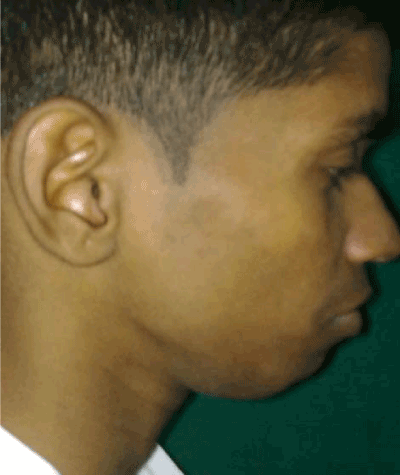A Rare Case of a Thyroglossal Duct Cyst in Sublingual and Submental Region Present as Submental Abscess
Received: 09-Mar-2012 / Accepted Date: 24-Apr-2012 / Published Date: 01-May-2012 DOI: 10.4172/2161-119X.1000111
251048Case Report
A 25 yr old young male presented with swelling in submental region (Figure 1) since 8 months. This swelling was subjected to reduce in size on pressing leading to purulent discharge from foramen caecum. There was no history of dysphagia or odynophagia.
Clinical examination
On examination there was 5 x 3 cm size swelling seen in submental region with no localised sign of inflammation. The swelling moved on protrusion of tongue and deglutination.
The swelling was soft in consistency and lead to purulent discharge from foramen caecum on pressing. There were no signs of cervical lymphadenopathy.
Ultrasonography and CT scan were suggestive of 4.4 x 1.8 cm size thyroglossal duct cyst in sublingual region opening into foramen caecum, with no significant lymphadenopathy (Figure 2). Thyroid gland was normal. Thyroid profile of the patient was normal (euthyroid). Pus culture was suggestive of staphylococcal infection.
Patient was admitted in the ward and posted for Sistrunk’s surgery. Intra-operatively cyst was found in sublingual and submental space extending up to foramen caecum with a thick band extending to the hyoid bone. We inject the methylene blue dye in to the opening present over the foramen caecum to delineate the tract and whole cyst identified. This cyst was ligated near the foramen caecum.
Excision of entire cyst was done with body of hyoid (Figure 3).
Histopathology report of the specimen was suggestive of thyroglossal duct cyst with no evidence of malignancy.
Discussion
The thyroid gland originates from the foramen cecum present in the floor of the pharyngeal gut on the 17th day of gestation. The gland then descends in front of the pharynx as a bilobed diverticulum which is initially patent. It reaches its final position in the neck by the 7th week of gestation. The duct usually disappears by the 10th week of gestation. Persistence of any portion of this duct could give rise to thyroglossal cyst. Commonly these cysts could contain thyroid tissue, hence I 131 studies should be considered in all patients with suspected ectopic thyroid. In this patient occult malignancy is more likely [3]. Rarely this could be the only functioning thyroid gland tissue.
Thyroglossal duct cysts most often present with a palpable asymptomatic midline neck mass below the level of the hyoid bone. The neck mass moves with swallowing. Some patients will have neck or throat pain, or dysphagia and the spectrum of clinical symptoms may be varied. Diagnosis is usually made clinically [4].
It has been reported that over 7% of adults have some remains of the thyroglossal duct and over 62% of them may have some ectopic thyroid tissue. Most neoplasias in the thyroglossal duct are made up of papillary carcinomas [5].
Antibiotics are indicated if infection is suspected. Definitive surgical management requires excision not only of the cyst but also of the path’s tract and branches.
Conclusion
This is a rare presentation of thyroglossal cyst in an adult patient presented with swelling in submental region.
References
- Ellis PD, Van Nostrand AW (1977) The applied anatomy of thyroglossal tract remnants. Laryngoscope 87: 765-770.
- Santiago W, Rybak LP, Bass RM (1985) Thyroglossal duct cyst of the tongue. J Otolaryngol 14: 261-264.
- Dedivitis RA, Camargo DL, Peixoto GL, Weissman L, Guimaraes AV (2002) Thyroglossal duct: a review of 55 cases. J Am Coll Surg 194: 274–277.
- Bhagavan BS, Rao DR, Weinberg T (1970) Carcinoma of the thyroglossal duct cyst: case reports and review of the literature. Surgery 67: 281-292.
Citation: Ahire DB, Thorawade V, Jagade M, Nagle S, Chopade T, et al. (2012) A Rare Case of a Thyroglossal Duct Cyst in Sublingual and Submental Region Present as Submental Abscess. Otolaryngology 2:111. DOI: 10.4172/2161-119X.1000111
Copyright: © 2012 Ahire DB, et al. This is an open-access article distributed under the terms of the Creative Commons Attribution License, which permits unrestricted use, distribution, and reproduction in any medium, provided the original author and source are credited.
Share This Article
Recommended Journals
Open Access Journals
Article Tools
Article Usage
- Total views: 17802
- [From(publication date): 6-2012 - Apr 07, 2025]
- Breakdown by view type
- HTML page views: 13199
- PDF downloads: 4603



